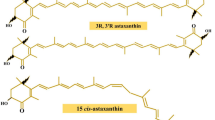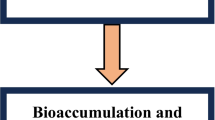Abstract
Cadmium (Cd) is an extremely toxic metal that induces a wide spectrum of toxic responses in organisms in the environment. In the present study, scallops (Patinopecten yessoensis), after acclimation for 1 week in the laboratory, were subjected to acute Cd chloride (CdCl2) toxicity, and ultramorphological and proteomic changes in their heart tissues were analyzed and compared with those of the nonexposed control group. Electron microscopy showed that ultrastructures of the cytoplasm and mitochondria in scallop hearts were badly damaged, and two-dimensional gel electrophoresis showed 32 protein spots that were differentially expressed after exposure to 10 mg/l CdCl2 for 24 h. Of these spots, 8 were upregulated, 16 were downregulated, and 8 showed low expression. Proteins from these spots were identified using matrix-assisted laser desorption/ionization-time of flight mass spectrometry and database searching. The results indicated that these proteins are involved in the regulation of cell structure, transport, signal transduction, and metabolism. Among other things, four proteins―identified as amino acid adenosine triphosphate (ATP)–binding cassette transporter, glycerol-3-phosphate dehydrogenase (nicotinamide adenine dinucleotide phosphate), nicotinamide adenine dinucleotide oxidase, and ATPase―were demonstrated to be especially associated with Cd toxicity. Some of the other proteins observed in this work are of particular interest in terms of their responses to Cd, which have not been reported previously. These data may provide novel biomarkers for monitoring the Cd contamination level of flowing seawater as well as provide useful insights into the mechanisms of Cd toxicity.




Similar content being viewed by others
References
Atli G, Canli M (2007) Enzymatic responses to metal exposures in a freshwater fish Oreochromis niloticus. Comp Biochem Physiol C: Toxicol Pharmacol 145:282–287
Beard SJ, Hughes MN, Poole RK (1995) Inhibition of the cytochrome bo’-terminated NADH oxidase system in Escherichia coli K-12 by divalent metal cations. FEMS Microbiol Lett 131:205–210
Bebianno MJ, Serafim MA (2003) Variation of metal and metallothionein concentrations in a natural population of Ruditapes decussates. Arch Environ Contam Toxicol 44:53–66
Berrada W, Naya A, Iddar A (2002) Purification and characterization of cytosolic glycerol-3-phosphate dehydrogenase from skeletal muscle of jerboa (Jaculus orientalis). Mol Cell Biochem 231:117–127
Bissell MJ, Rambeck WA, White RC, Bassham JA (1976) Glycerol phosphate shuttle in virus-transformed cells in culture. Science 191:856–858
Bovet L, Feller U, Martinoia E (2005) Possible involvement of plant ABC transporters in cadmium detoxification: a cDNA sub-microarray approach. Environ Int 31:263–267
Canli M, Stagg RM (1996) The effects of in vivo exposure to cadmium, copper, and zinc on the activities of gill ATPases in the Norway lobster Nephrops norvegicus. Arch Environ Contam Toxicol 31:491–501
Daud MK, Sun YQ, Dawood M (2009) Cadmium-induced functional and ultrastructural alterations in roots of two transgenic cotton cultivars. J Hazard Mater 161:463–473
de Zwart M, van der Goot H, Timmerman H (1991) Influence of Co(II), Ni(II), Cu(II), Zn(II) and Cd(II) on growth inhibition and enzyme activity of Mycoplasma gallisepticum in the absence or presence of a 2, 2′-bipyridyl type ligand. Eur J Med Chem 26:101–108
Dudley RE, Svoboda DJ, Klaassen CD (1984) Time course of cadmium-induced ultrastructural changes in rat liver. Toxicol Appl Pharmacol 76:150–160
Erman JE, Vitello LB (2002) Yeast cytochrome c peroxidase: mechanistic studies via protein engineering. Biochim Biophys Acta 1597:193–220
Everett CJ, Frithsen IL (2008) Association of urinary cadmium and myocardial infarction. Environ Res 106:284–286
Feng LJ, Huang L, Zhuo HQ, Huang HQ (2008) Differential proteins of Panax notoginseng powder inducement identified and analyzed with proteomic techniques in neural connective of Aplysia. Chin J Anal Chem 36:577–582
Fernandez EL, Gustafson AL, Andersson M, Hellman B, Dencker L (2003) Cadmium-induced changes in apoptotic gene expression levels and DNA damage in mouse embryos are blocked by zinc. Toxicol Sci 76:162–170
Gaisser HD, Vries JD, Van Der Goot H, Timmerman H (1987) Inhibition of NADH oxidase and lactate dehydrogenase of Mycoplasma gallisepticum by copper complexes of 2,2′-bipyridyl analogues. Biochem Pharmacol 36:3237–3241
Géret F, Serafim A, Barreira L, Bebianno MJ (2002) Effect of cadmium on antioxidant enzyme activities and lipid peroxidation in the gills of the clam Ruditapes decussates. Biomarkers 7:242–256
Grosell M, Wood CM, Walsh PJ (2003) Copper homeostasis and toxicity in the elasmobranch Raja erinacea and the teleost Myoxocephalus octodecemspinosus during exposure to elevated water-borne copper. Comp Biochem Physiol C: Toxicol Pharmacol 135:179–190
He XQ, Chen MG, Ma Q (2008) Activation of Nrf2 in defense against cadmium-induced oxidative stress. Chem Res Toxicol 21:1375–1383
Higgins CF (2001) ABC transporters: physiology, structure and mechanism―an overview. Res Microbiol 152:205–210
Jamall IS, Smith JC (1985) Effects of cadmium on glutathione peroxidase, superoxide dismutase, and lipid peroxidation in the rat heart: a possible mechanism of cadmium cardiotoxicity. Toxicol Appl Pharmacol 80:33–42
Jin XF, Yang X, Islam E (2008) Effects of cadmium on ultrastructure and antioxidative defense system in hyperaccumulator and non-hyperaccumulator ecotypes of Sedum alfredii Hance. J Hazard Mater 156:387–397
Lau ATY, Chiu JF (2007) The possible role of cytokeratin 8 in cadmium-induced adaptation and carcinogenesis. Cancer Res 67:2107–2113
Limaye DA, Shaikh ZA (1999) Cytotoxicity of cadmium and characteristics of its transport in cardiomyocytes. Toxicol Appl Pharmacol 154:59–66
Ling XP, Zhu JY, Huang L, Huang HQ (2009) Proteomic changes in response to acute cadmium toxicity in gill tissue of Paralichthys olivaceus. Environ Toxicol Pharmacol 27:212–218
Lionetto MG, Giordano ME, Vilella S, Schettino T (2000) Inhibition of eel enzymatic activities by cadmium. Aquat Toxicol 48:561–571
Maret W, Yetman CA, Jiang LJ (2001) Enzyme regulation by reversible zinc inhibition: glycerol phosphate dehydrogenase as an example. Chem Biol Interact 130–132:891–901
Matz CJ, Krone PH (2007) Cell death, stress-responsive transgene activation, and deficits in the olfactory system of larval zebrafish following cadmium exposure. Environ Sci Technol 41:5143–5148
Nagya Z, Montignya C, Leverrier P (2006) Role of the yeast ABC transporter Yor1p in cadmium detoxification. Biochimie 88:1665–1671
Navas-Acien A, Silbergeld EK, Sharrett R, Calderon-Aranda E, Selvin E, Guallar E (2005) Metals in urine and peripheral arterial disease. Environ Health Perspect 113:164–169
O’Brien P, Salasinski HJ (1998) Evidence that the reactions of cadmium in the presence of metallothionein can produce hydroxyl radicals. Arch Toxicol 72:690–700
Ognjanovi BI, Markovi SD, Pavlovi SZ, Zikic RV, Stajn SA, Saicic ZS (2006) Combined effects of coenzyme Q10 and vitamin E in cadmium induced alterations of antioxidant defense system in the rat heart. Environ Toxicol Pharmacol 22:219–224
Park HJ, Reiser COA, Kondruweit S, Erdmann H, Schmid RD, Sprinzl M (1992) Purification and characterization of a NADH oxidase from the thermophile Thermus thermophilus HB8. Eur J Biochem 205:887–893
Pettersen AJ, Andersen R, Zachariassen KE (2002) Effects of dietary intake of trace metals on tissue contents of sodium and calcium in mice (Mus musculus). Comp Biochem Physiol C: Toxicol Pharmacol 132:53–60
Prozialeck WC, Edwards JR, Woods JM (2006) The vascular endothelium as a target of cadmium toxicity. Life Sci 79:1493–1506
Quig D (1998) Cysteine metabolism and metal toxicity. Altern Med Rev 3:262–270
Rea PA, Li ZS, Lu YP, Drozdowicz YM, Martinoia E (1998) From vacuole GS-X pumps to multispecific ABC transporters. Annu Rev Plant Physiol Plant Mol Biol 49:727–760
Risso-de Faverney C, Devaux A, Lafaurie M, Girard JP, Bailly B, Rahmani R (2001) Cadmium induces apoptosis and genotoxicity in rainbow trout hepatocytes through generation of reactive oxygen species. Aquat Toxicol 53:65–76
Ross RP, Claiborne A (1992) Molecular cloning and analysis of the gene encoding the NADH oxidase from Streptococcus faecalis 10C1: comparison with NADH peroxidase and the flavoprotein disulfide reductases. J Mol Biol 227:658–671
Rustichelli C, Visioli G, Kostecka D (2008) Proteomic analysis in the lichen Physcia adscendens exposed to cadmium stress. Environ Pollut 156:1121–1127
Stohs SJ, Bagchi D (1995) Oxidative mechanisms in the toxicity of metal ions. Free Radic Biol Med 18:321–336
Stohs SJ, Bagchi D, Hassoun E, Bagchi M (2001) Oxidative mechanisms in the toxicity of chromium and cadmium ions. J Environ Pathol Toxicol Oncol 20:77–88
Suresh A, Sivaramakrishna B, Radhakrishnaiah K (1995) Cadmium induced changes in ion levels and ATPase activities in the muscle of the fry and fingerlings of the freshwater fish, Cyprinus carpio. Chemosphere 30:367–375
Surin BP, Rosenberg H, Cox GB (1985) Phosphate-specific transport system of Escherichia coli: nucleotide sequence and gene-polypeptide relationships. J Bacteriol 161:189–198
Thevenod F, Friedmann JM (1999) Cadmium-mediated oxidative stress in kidney proximal tubule cells induces degradation of Na+/K+-ATPase through proteasomal and endo-/lysosomal proteolytic pathways. FASEB J 13:1751–1761
Tomera JF, Lilford K, Kukulka SP, Friend KD, Harakal C (1994) Divalent cations in hypertension with implications to heart disease: calcium, cadmium interactions. Methods Find Exp Clin Pharmacol 16:97–107
Toury R, Biossanneau E, Stelly N, Dupuis Y, Berville A, Perasso R (1985) Mitochondria alteration in Cd treated rats: general regression of inner membrane cristae and electron transport impairment. Biol Cell 55:71–85
Vallee BL, Ulmer D (1972) Biochemical effects of mercury, cadmium, and lead. Annu Rev Biochem 41:91–128
Varoni MV, Palomba D, Gianorso S, Anania V (2003) Cadmium as an environmental factor of hypertension in animals: new perspectives on mechanisms. Vet Res Commun 27:807–810
Waisberg M, Joseph P, Hale B, Beyersmann D (2003) Molecular and cellular mechanisms of cadmium carcinogenesis: a review. Toxicology 192:95–117
Yu XZ, Hong SW, Faustman EM (2008) Cadmium-induced activation of stress signaling pathways: disruption of ubiquitin-dependent protein degradation and apoptosis in primary rat sertoli cell-gonocyte cocultures. Toxicol Sci 104:385–396
Zhuo HQ, Jin HW, Huang HQ, Huang HY, Cai ZW (2007) Stability and splitting produces revealed by matrix-assisted laser desorption ionization-time of flight-mass spectrometry in human serum transferrin. Chin J Anal Chem 35:791–796
Zyadah MA, Abdel-Baky TE (2000) Toxicity and bioaccumulation of copper, zinc, and cadmium in some aquatic organisms. Bull Environ Contam Toxicol 64:740–747
Acknowledgments
This work was funded by grants from the State Natural Science Fund (Grants No. 30870515 and 40776060) and 973 Projects (No. 2010CB12640), China. We thank John Hodgkiss for assistance with the English in this manuscript.
Author information
Authors and Affiliations
Corresponding author
Rights and permissions
About this article
Cite this article
Huang, QY., Fang, CW. & Huang, HQ. Alteration of Heart Tissue Protein Profiles in Acute Cadmium-Treated Scallops Patinopecten yessoensis . Arch Environ Contam Toxicol 60, 90–98 (2011). https://doi.org/10.1007/s00244-010-9533-2
Received:
Accepted:
Published:
Issue Date:
DOI: https://doi.org/10.1007/s00244-010-9533-2




